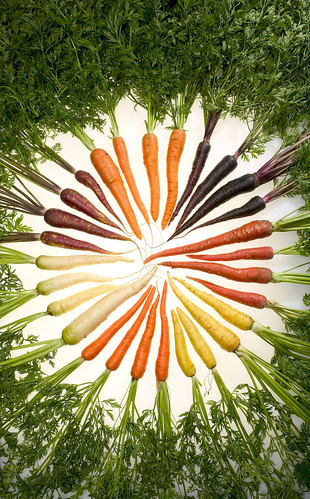
This post is part of the Science Tuesday feature series on the USDA blog. Check back each week as we showcase stories and news from USDA’s rich science and research portfolio.
Organic carrots are coming into their own. About 14 percent of U.S.-produced carrots are now classified as organic, making carrots one of the highest ranked crops in terms of the total percentage produced organically. With production and demand increasing in recent years, organic-carrot growers need help deciding which varieties to grow. Some varieties perform well as a conventional crop, but not so well under organic conditions. While conventional growers also can fumigate to control nematodes, bacterial diseases and fungal pathogens, organic growers don’t have that option.
That’s why the work of Agricultural Research Service (ARS) plant geneticist Philipp W. Simon and his colleagues is so important. Simon, who is the research leader of ARS’s Vegetable Crops Research Laboratory in Madison, Wisconsin, is leading the five-year Carrot Improvement for Organic Agriculture (CIOA) project that is ultimately aimed at providing information and helping breeders develop carrots that are tastier, more nutritious and better equipped to combat weeds, diseases and pathogens. It is funded with a National Institute of Food and Agriculture, Organic Agriculture Research and Extension Initiative grant.
The researchers are growing 36 carrot varieties in organic and conventional fields at four locations and comparing them for flavor, productivity, appearance, color, disease resistance and other key traits. Partners include researchers from Purdue University, the University of Wisconsin-Madison, the University of California-Riverside, Washington State University and the Organic Seed Alliance. The field trials are in Madison, Wisconsin, Pasco, Washington, West Lafayette, Indiana, and Bakersfield, California.
Carrots grow relatively slowly, and that means that faster-growing weeds are a major problem. Some large-scale organic producers in California estimate that they spend thousands of dollars per acre to weed carrot fields. A priority highlighted by the research is the need for carrots that can produce their large, above-ground leafy “tops” quickly to outcompete weeds for sunlight and moisture.
Organic growers also are more interested than conventional growers in producing carrots with novel shapes and colors—purple, red and yellow—that will attract organic consumers, according to Simon. When it comes to nutrition and health, orange carrots are always a good choice because they are high in vitamin A, an essential nutrient. But changing up your carrot color scheme once in a while might not be a bad idea, he says. Purple carrots have powerful antioxidants. Yellow ones are a good source of lutein, which could reduce the risk of macular degeneration, an all too common eye problem. Red carrots are high in lycopene, a nutrient associated with reducing the risk of certain cancers.
The researchers are still evaluating the 16 named carrot varieties and 20 scientific lines selected for the project. That includes assessing them for flavor, a major issue for consumers. When the market for baby carrots started to take off years ago (baby carrots account for about half of all the fresh carrots consumed in the United States), consumers came to expect carrots to taste good, and growers were quick to adapt, according to Simon. “That message has come through clearly. Flavor is a priority because if people don’t want to eat carrots, they’re not going to buy them.”

